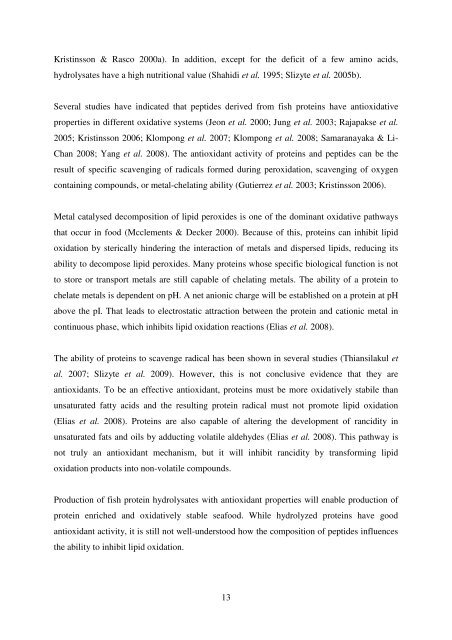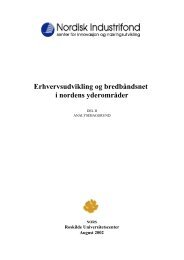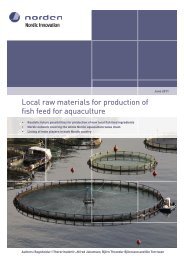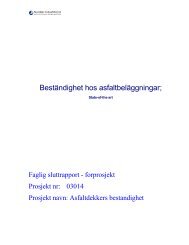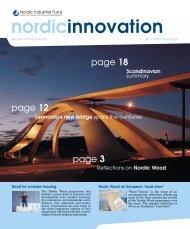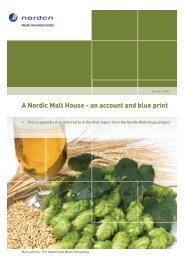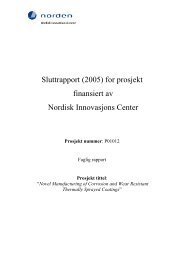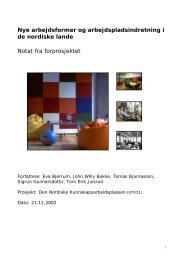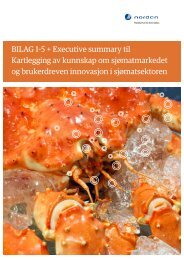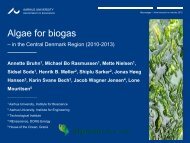Value added fish by-products - Nordic Innovation
Value added fish by-products - Nordic Innovation
Value added fish by-products - Nordic Innovation
You also want an ePaper? Increase the reach of your titles
YUMPU automatically turns print PDFs into web optimized ePapers that Google loves.
Kristinsson & Rasco 2000a). In addition, except for the deficit of a few amino acids,<br />
hydrolysates have a high nutritional value (Shahidi et al. 1995; Slizyte et al. 2005b).<br />
Several studies have indicated that peptides derived from <strong>fish</strong> proteins have antioxidative<br />
properties in different oxidative systems (Jeon et al. 2000; Jung et al. 2003; Rajapakse et al.<br />
2005; Kristinsson 2006; Klompong et al. 2007; Klompong et al. 2008; Samaranayaka & Li-<br />
Chan 2008; Yang et al. 2008). The antioxidant activity of proteins and peptides can be the<br />
result of specific scavenging of radicals formed during peroxidation, scavenging of oxygen<br />
containing compounds, or metal-chelating ability (Gutierrez et al. 2003; Kristinsson 2006).<br />
Metal catalysed decomposition of lipid peroxides is one of the dominant oxidative pathways<br />
that occur in food (Mcclements & Decker 2000). Because of this, proteins can inhibit lipid<br />
oxidation <strong>by</strong> sterically hindering the interaction of metals and dispersed lipids, reducing its<br />
ability to decompose lipid peroxides. Many proteins whose specific biological function is not<br />
to store or transport metals are still capable of chelating metals. The ability of a protein to<br />
chelate metals is dependent on pH. A net anionic charge will be established on a protein at pH<br />
above the pI. That leads to electrostatic attraction between the protein and cationic metal in<br />
continuous phase, which inhibits lipid oxidation reactions (Elias et al. 2008).<br />
The ability of proteins to scavenge radical has been shown in several studies (Thiansilakul et<br />
al. 2007; Slizyte et al. 2009). However, this is not conclusive evidence that they are<br />
antioxidants. To be an effective antioxidant, proteins must be more oxidatively stabile than<br />
unsaturated fatty acids and the resulting protein radical must not promote lipid oxidation<br />
(Elias et al. 2008). Proteins are also capable of altering the development of rancidity in<br />
unsaturated fats and oils <strong>by</strong> adducting volatile aldehydes (Elias et al. 2008). This pathway is<br />
not truly an antioxidant mechanism, but it will inhibit rancidity <strong>by</strong> transforming lipid<br />
oxidation <strong>products</strong> into non-volatile compounds.<br />
Production of <strong>fish</strong> protein hydrolysates with antioxidant properties will enable production of<br />
protein enriched and oxidatively stable seafood. While hydrolyzed proteins have good<br />
antioxidant activity, it is still not well-understood how the composition of peptides influences<br />
the ability to inhibit lipid oxidation.<br />
13


